Fifty-six male patients who had chronic low-back pain of at least 12 weeks' duration (average duration, 28.6 weeks) and who had failed to respond to traditional medical or surgical therapy were entered into a randomized clinical trial to compare the relative efficacies of the clinic's standard therapy regimen with and without dry needling at muscle motor points. Before entering the trial, all patients had undergone without improvement eight weeks of the Clinic's standard therapy regimen of physiotherapy, remedial exercises, and occupational therapy. The 29 study subjects and 27 control patients then continued with this regimen, but the study subjects also received needling at muscle motor points once or twice a week (average number of treatments, 7.9). All patients were assessed at the time of discharge, 12 weeks after discharge, and at the time of writing (average, 27.3 weeks). The group that had been treated with needling was found to be clearly and significantly better than the control group (P>2.005, N=53) with regard to status at discharge, status at 12 weeks' follow-up, and status at final follow-up. At final follow-up, 18 of the 29 study subjects had returned to their original or equivalent jobs and 10 had returned to lighter employment. In the control group, only four had returned to their original work and 14 to lighter employment; nine were still disabled. The results seem to justify the procedure in chronic low-back patients in whom myofascial pain (the majority) rather than skeletal irritation is the dominant disabling feature. [Key words: low-back pain, tender motor points, dry needling desensitization]
Wall, commenting on the acupuncture for pain therapy in the 1974 International Symposium on Pain, divided acupuncture into two categories:
Wall thought that the results presented at the International Symposium constituted a new phenomenon that was interesting and deserving of further exploration.
Modern acupuncture is commonly carried out in one of two fashions. The more traditional form of acupuncture involves the placement of a small needle into an acupuncture point with mechanical agitation of the needle by hand motion. More recently, acupuncturists have introduced the use of small, portable electrical stimulators connected to the needles to provide continuous stimulation. This latter technique is sometimes referred to as subcutaneous electrical stimulation (SES) to distinguish it from transcutaneous or percutaneous electrical stimulation via surface electrodes (TNS or TENS).
The relative efficacies of these forms of stimulation on the peripheral nerve or on local skin points in relieving pain of diverse causes have been well documented, 34,38,40,45,46 and since 1974 transcutaneous neural stimulation has been one of the standard modalities of physical treatment in this Rehabilitation Clinic's Physiotherapy Department.
The conservative management of low-back pain, in our experience, is seen to fall into three broad categories (Figure 1):
The purpose of this clinical trial is to investigate whether dry needling of muscle motor points (in this study using points for stimulation based on neurophysiologic concepts) has anything to offer to this group of patients who have "chronic low-back pain."
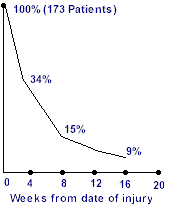
Fig 1. The natural history of low-back injury. A survey of 173 patients in 1975 showed that most (85%) are recovered by the eighth week regardless of the modality of treatment. After the 12th week there remains a resistant group of less than 10% in whom progress is extremely slow.
MATERIALS AND METHODS
The Workers' Compensation Board of British Columbia operates an outpatient rehabilitation clinic to provide rehabilitative treatment for patients following all aspects of industrial trauma.
"Low-back pain," a vague term encompassing a multitude of disorders, is one of the commonest disabilities seen at the Rehabilitation Clinic. In 1975, total admissions for all types of injuries numbered almost 5000. Of these, 33% were for injuries to the lumbar spine. The majority (86%) of these lumbar spine patients were admitted with the working diagnosis of "low-back pain." The remainder had fractures or were postoperative patients (eg, laminectomy, spinal fusion).
The standard approach to management of "low-back pain" in British Columbia compensation cases is as follows: The acute phase of the disability is generally treated conservatively by the attending physician, who may prescribe bed rest, application of heat, analgesics, muscle relaxants, injections of local anesthetic with or without cortisone, and sometimes manipulation. Following this regimen, the majority of patients return to work after a comparatively short time - probably a few days to two weeks. If severe symptoms persist, the patient is then referred to a consultant.
Once the patients is past the acute phase, the attending physician may refer the patient to the Clinic for treatment.
A comprehensive and progressive back program consisting of physiotherapy, remedial exercises, occupational therapy, and industrial assessment has been designed for the treatment of low-back sprain. The aims of treatment are to alleviate symptoms (pain and muscle spasm), to improve posture and musculature, to provide instruction in the care of the back, including proper bending and lifting techniques, and to provide work conditioning and testing when necessary.
During the period between June 21, 1976, and June 9, 1977, total admissions for all injuries numbered 3642 patients; of these, 1510 were seen for a low-back disability. For the purposes of this study, subjects were considered eligible only after they had already been disabled for at least 12 weeks to avoid including those (the majority) who might be making a spontaneous recovery according to the natural history of low-back pain (Figure 2). Also, to ensure that these study subjects had had proper and adequate conservative treatment, they were given eight weeks of the standard Clinic regimen before admission into the Clinical Trial. Only male patients were selected to exclude possible (though rare) low-back pain from referred gynecologic sources. Patients who had "psychosomatic backache" or in whom psychological disturbances constituted the dominating feature of the overall clinical picture were also excluded. Contrary to widespread belief, back pain of an entirely psychological origin and unrelated to any structural dysfunction is uncommon, although many of our patients doubtless did have as aggravating factors some secondary psychological disturbances to a variable degree. The injury may have been the patient's first one or a subsequent reinjury with postoperative patients included. All patients were given roentgenograms of the lumbosacral spine including oblique views and, when indicated, an electromyographic examination. Patients were divided into three age groups: 35 years and under, 36 to 45 years, and 46 years and over. Their ages ranged from 20 to 62 years; average age was 40.6 years. Permission for the trial was obtained from attending physicians, and the patients were required to sign a consent form. At the end of the eight weeks of standard clinic treatment, the referring clinic physician, there were persistent disabling pain despite all traditional medical or surgical therapy and recovery was deemed absent. Because of these selective parameters, the number of study subjects was relatively small. Of 1510 patients admitted because of low-back pain, 147 fulfilled the criteria and were screened by the clinic physicians; 18 declined this procedure and 73 had shown some improvement after the eight weeks' standard clinic regimen. There remained a small refractory group of 56 patients (3.7% of 1510) who continued to have persistent disability and qualified for the randomized clinical trial (Tables 1 and 2). Disability periods varied from 12 to 168 weeks, with an average disability period of 28.6 weeks before treatment. Both groups, study group A and control group C, continued with the standard clinic regimen, but the study group A, in addition, received needle insertions at motor points once or twice a week for a projected total of ten treatments. If the patient showed a quick initial response, fewer treatments were given. If the response was satisfactory but some symptoms persisted after ten treatments, additional treatments were added. The maximum number of treatments required was 15 (in one patient), and generally those additional treatments or "booster shots" were given after the patients had returned to work (Table 1). The average number of treatments was 7.9. All patients in both groups continued to be reviewed by the referring clinic physician every one or two weeks and were assessed and discharged by the physicians when symptomatically improved. Follow-ups were at 12 weeks following discharge and again at the time of writing (12 to 61 weeks, average 27.3) when the patients and/or their attending physicians were contacted by telephone or letter. (This was done by the Rehabilitation Clinic's clerical staff.) The patient's pain and work status was recorded as follows:
At the time of writing (September 1, 1977), the status of each patient was again similarly reviewed and recorded (Tables 1 and 2).
In the selection of points for treatment, we have dispensed with the traditional, empiric principles of the meridian system. Instead, points were chosen on a neurophysiologic basis and in accordance with the segmental level of injury. It is now generally accepted that most acupuncture points correspond to muscle motor points. A motor point is defined as the skin region where an innervated muscle is most accessible to percutaneous electrical excitation at the lowest intensity. This point, on the skin, generally lies over the neurovascular hilus of the muscle and the muscle's band or zone of innervation. Muscle fibers do not always extend the whole length of a muscle, and myoneural junctions are not uniformly spread out all over the muscle but are concentrated in a confined area - the zone or band of innervation where the greatest concentration of motor end-plates and other large-diameter nerve fibers may be reached with less concurrent painful stimulation of the smaller-diameter cutaneous fibers (a common complaint of patients in transcutaneous neural stimulation) (Figure 2). In this study, muscle motor points or, more accurately, motor bands belonging to the affected myotome were chosen for treatment, ignoring the dermatomal levels of the overlying skin points which may not necessarily coincide spatially with the myotomal level of the underlying muscles. For example, in treating an injury between the L3 and L4 vertebrae affecting the L4 nerve root, we would address the motor bands in the muscles of L4 myotome (see Table 3). The fourth lumbar myotome includes the following muscles: the anterior tibial innervated by the fourth and fifth lumbar roots coming through the deep peroneal nerve, the tensor fascia lata innervated by the fourth and fifth lumbar roots coming through the superior gluteal nerve, and the quadriceps femoris innervated by the second, third, and fourth lumbar roots coming through the femoral nerve. Emphasis was placed upon those muscles that showed myalgic hyperalgesia or tenderness to digital pressure. May of these motor bands were also palpable due to local muscle spasm. Tenderness in several muscles of one myotome innervated by several peripheral nerves differentiated the lesion from a peripheral neuropathy involving one nerve; similarly, when the lesion was at root level, muscles innervated by both the anterior and posterior primary rami were logically involved. Therefore, when the L4 myotome was affected, its erector spinae muscles (posterior primary ramus) were also treated. Although symptoms may have been unilateral, as often as not both sides were involved and a search was made for unsuspected tender motor bands on the symptom-free side, which also received treatment.
Table 1. Group A--29 Patients Who Received Dry-Needling In Addition To Standard Clinic Regimen
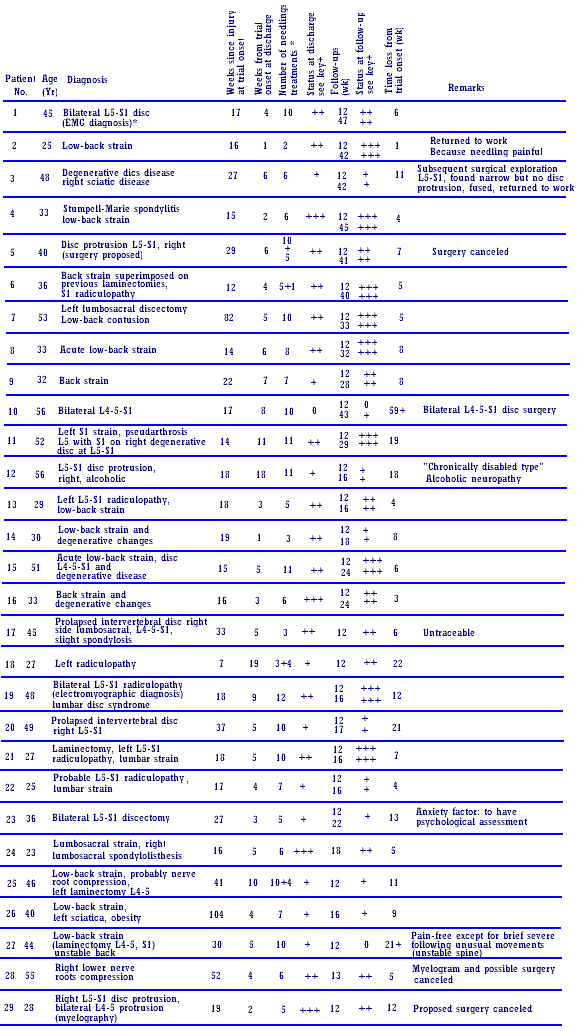
Table 2. Group C--Patients Who Continued With The Standard Clinic Regiman (No Dry-Needling)

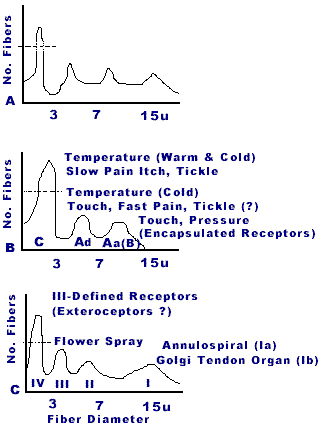
Fig 2. An analysis of the composition of the fiber diameters in the dorsal root shows that most of the large-diameter fibers are derived from the muscle nerve. A. Dorsal root fibers. B. Cutaneous nerve (exteroceptors). C. Muscle nerve (proprioceptors). (From Eyzaguirre C, Fidone SJ: Physiology of the Nervous System. Second edition. Copy-right Year Book Medical Publishers, Inc., Chicago. Used by permission.)
The exact location of a motor band or motor line may vary slightly from patient to patient, but the relative position follows a fairly fixed pattern. Some motor bands or lines are superficial and are easily found while others belonging to deep muscles are more difficult to locate.
The classical acupuncturist recognizes hundreds of acupuncture points which have been documented in the Chinese literature of various periods, historical and contemporary. Most of these points are located in a linear arrangement along the major "meridians" of the body. Traditionally, such points are identified by measuring from easily identifiable anatomic landmarks using the patient's long finger, middle phalanx as the standard unit. In recent years, the dermometer, now renamed the neurometer, has been adopted for point location. The principle of the neurometer is similar to that of a standard calibration-stable stimulator with variable control of output used to evoke muscle twitches in response to minimal electrical stimulation. In stimulation, the skin over motor points has least resistance to the electric current as terminal branches of the muscle nerve there lie closest to the skin, and upon completion (or breaking) of the electrical current between the electrodes via the patient's body, a muscle twitch is produced.
Table 3. Segmental Innervation of the Muscles of the Lower Limb Tested for Tender Motor Points.*
| Predominant cord segment L2 L3 L4 L5 S1 S2 | Muscle (segmental innervation) Sartorius (L2, L3) Pectineus (L2, L3) Adductor longus (L2, L3) Quadriceps femoris (L2-4) Quadriceps femoris (L2-4) Tensor fasciae latae (L4, L5) Tibialis anterior (L4, L5) Gluteus medius (L4-S1) Semimembranosus (L4-S1) Semitendinosus (L4-S1) Extensor hallucis longus (L4-S1) Gluteus maximus (L4-S2) Biceps femoris, short head (L5-S2) Semitendinosus (L4-S1) Medial gastrocnemius (S1, S2) Soleus (S1, S2) Biceps femoris, long head (S1-S2) Lateral gastrocnemius (S1-S2) Soleus (S1,S2) | Peripheral nerve Femoral Obturator Obturator Femoral Femoral Superior gluteal Peroneal Superior gluteal Sciatic Sciatic Deep peroneal Inferior gluteal Sciatic Sciatic Tibial Tibial Sciatic Tibial Tibial |
* Most muscles receive their innervation from more than one segment of the spinal cord, as indicated in this table in parentheses. The segments listed on the left are those generally accepted as the predominant source of innervation of the muscles in question, all of which are innervated by the anterior rami whose fibers pass along the nerve indicated on the right. The posterior rami from these same cord segments are distributed to the corresponding levels of the erector spinae muscles, but there is extensive overlapping of the posterior rami.
The neurometer is a simple instrument powered by dry cells (generally 9-21 V) and consisting of a milliammeter with a probe and ground or indifferent electrode. The indifferent electrode is held in the hand of the patient while the probe explores the body surface for areas where resistance to direct current is lowest.
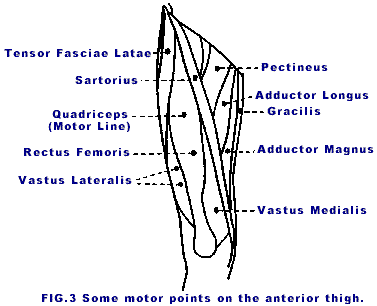

When the probe alights on such a point, it emits an audible signal and the milliammeter shows a reading. Unlike the standard calibration-stable stimulator with visible muscle contraction as the indicator, the neurometer is not specific; it indicates a skin point that has low electrical resistance, but not all such points are necessarily over motor bands. The accuracy of a neurometer has further been criticized because skin resistance to direct current may vary according to room humidity, skin temperature, autonomic or sudomotor activity, voltage, and other factors; but in any one individual, under any given set of conditions, there is a definite relative difference in skin resistance over a motor band as compared with surrounding skin. In practice, we had been able almost invariably to dispense with a neurometer because motor bands are known anatomic entities at fixed anatomic sites which vary only slightly from person to person. Moreover, those bands that require attention were frequently palpable or tender and thus easily found. Charts showing the distribution of motor bands or "points" are generally available, the earliest was prepared by the neurologist Wilhelm Erb in 1882. An atlas of neurovascular hila of limb muscles is also available, and there is an excellent anatomic guide for the electromyographer. It is interesting to note that a comparison of a traditional acupuncture chart with a chart of motor points will show many similarities.
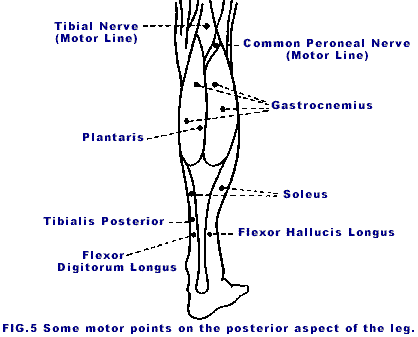
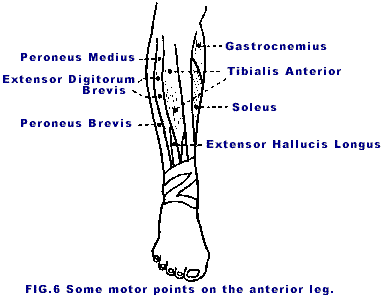
The techniques we used for needle insertion and mechanical stimulation were borrowed from traditional acupuncture. Acupuncture needles made of stainless steel and of three lengths were used (3, 4, and 5 cm). The selection of the length of needles was dictated by the location of the points to be treated; deeper and thicker muscles required longer needles. Acupuncture needles are longer, finer, and more whippy than hypodermic needles and are particularly suited for deep muscle exploration. The preferred diameter was 30 gauge. Any finer gauge would render the needle unsuitable for reuse if mechanical stimulation was followed by the intense, local muscle contractions likely in neuropathy when the muscle is irritable from denervation supersensitivity. This reflex muscle contraction is termed "needle-grasp" by the traditional acupuncturist and is comparable to the increased insertional activity seen in electromyography. Needles were sterilized by autoclaving, and standard precautionary techniques for asepsis were followed (hands scrubbed, no gloves, and skin cleansed with alcohol). The direction of needle insertions (using tubular guides) was perpendicular to the skin with the objective of penetrating the muscle zone of innervation. Mechanical stimulation was by "pecking" and "twirling" movements which are probably specific for the mechanoreceptors whose terminal membranes are especially sensitive to stretch deformation. Even when a stimulation needle is not exactly situated at the fairly narrow transverse band of innervation, the relative afferent barrage of generated potentials will be smaller but not entirely "zero." An electric current is often used by modern acupuncturists to augment the effect of the needle because larger-diameter fibers have a lower threshold to electricity, and if the current is of sufficient intensity it may "jump the gap" when the needle is not precisely placed. Electrical stimulation used in this study was in the form of a low voltage (9V) interrupted direct current* administered for a few seconds to each point or a phasic current applied for approximately 15 minutes when visible muscle fibrillations indicating proper needle placement were produced with minimal electrical intensity (less than that required for stimulation via skin). However, any phasic current stimulator has a limited number of available electrode terminals, and we used phasic stimulation only when there were four (our instrument's limit) or fewer points to treat. We have found in the course of treating patients within and without the trial that, provided a needle had been accurately placed, electrical stimulation showed little advantage over mechanical agitation. The penetrating needle, apart from stimulation by motional disturbance, also created a current of injury that persisted for several days until the traumatized region healed.
For the several motor bands within a myotome belonging to both anterior and posterior primary rami which required treatment, we had initially used multiple needles, but subsequently we preferred the convenient use of only one needle in a plunger-type needle-holder, which allowed the same needle to be used at multiple loci.
The traditional acupuncturist is guided in his needle placement by the patient's subjective appreciation of the "The Ch'I Phenomenon." This is a vague feeling described as a "soreness," "heaviness or pressure," "numbness," "fullness," or "distention" and is reported by the patient when the needle is at the neurovascular hilus where there is a concentration of a variety of receptor fibers in the muscle nerve: proprioceptors and mechanoreceptors which mediate pressure, muscle stretch, and limb position; nociceptors (pain); and possibly autonomic interoceptors. The simultaneous excitation of all these receptors or their fibers probably yields the "mixed-up" or difficult to describe, subjective sensation of "The Ch'i."
The design of the experiment was randomized blocks, where the blocks were defined with respect to the two factors of age and pre-experiment operation status. Each block consisted of two patients, one of whom was randomly assigned to a continuation of his standard clinic therapy while the other received a continuation of his standard therapy plus a series of needle insertion treatments. There were three age groups (under 30, 31 to 45, and over 46 years) and two pre-experiment operation statuses (previous back operation or not), so that there were six kinds of blocks.
The blocks were formed as the subjects became eligible to enter the experiment. That is, as the first two subjects from each "age group/operation status" combination entered the experiment, they became the first block, the second pair became the second block, and so forth. The first subject from each pair was assigned the needling treatment and the second, the standard treatment. Because patients became eligible in random order, this procedure constituted a random assignment to treatments and also had the advantage of helping to keep the sample balanced when some needled patients dropped out of the experiment. The date from any unbalanced blocks were included in the analysis by means of the covariance procedure that will be described.
Four analyses were done, one for each of the result statistics described in the previous paragraph. If only one follow-up was done for a subject, it was considered to be both the earlier and the later follow-up. In an attempt to allow for the fact that the method of follow-up varied among subjects, as did the number of weeks between discharge and follow-up, these two variables were included in the analysis. That is, in the second analysis, besides the independent variables of age, previous operation status, and needling/control, we included the variables "method of follow-up" and "number of weeks between discharge and earlier follow-up." In the third analysis, the two additional variables were "method of follow-up" and "number of weeks between discharge and later follow-up."
Subjects A17, C10, and C18 were not included in the analyses because we could not trace these patients.
In the analyses, some of the variables were treated as numeric, and some as categoric:
| Numeric
Variables Number of weeks between discharge and follow up Number of weeks of time loss Status at discharge, status at follow-up | Units Weeks Weeks Status 0 - assigned the value of 1 Status + - assigned the value of 2 Status ++ - assigned the value of 3 Status +++ - assigned the value of 4 |
| Categoric
Variables Treatment Age Method of follow-up Operation status | Categories Needling; control <30; 31-45; 46+ Contacting patient; medical reports; WCB staff; no personal contact No previous operation; previous operation |
Each of the four analyses (which are analyses of covariance because there are numeric variables combined with categoric variables) hypothesizes a certain parametric model. For example, in the third analysis the following model is hypothesized:

The analysis of covariance then determines the set of parameters, that is, it finds a value for u,A, A, O, M, M, M, T, and {a} that best accounts for the variation in "Status at later follow-up." It also tests the parameters for statistical significance. (It will be noted that in each group of parameters, eg, the age parameters, one has been fixed at zero. This is simply an arbitrary designation that must be made in this type of analysis.)
The results of the significance testing are shown in Tables 4 through 7. Values for the significant parameters are given at the bottom of this page.

The main result is that dry needling of muscle motor points was found to be clearly and significantly better than the control treatment in the tree "status" analyses (P>0.005,N=53), and was on the verge of being significantly better in the "weeks of time loss" analysis. In the latter, the significance of needling was at the 90th percentile (P>0.10, N=53). That is, the probability that the observed reduction in time loss for the dry needling patients could have occurred by chance is 10%. For all three "status" analyses, the improvement due to needling was almost exactly one status level; for the "weeks of wage loss" analysis it was one-half week of wage loss.
At the final follow-up, 18 of the 29 study subjects had returned to their original or equivalent jobs and ten to lighter employment. In the control group, only four had returned to their original work, and 14 to lighter employment, while nine were still disabled. An interesting result was that "method of follow-up" was a significant factor in the two "status" analyses involving a follow-up. Better statuses were reported for patients who were contacted directly (by letter or telephone) than for patients whose status reports were collected by one of the indirect methods.
Age was also a significant factor in two of the analyses: the men under 30 years responded better to treatment than did the men over 30.
DISCUSSION
Any discussion of the problem of low-back pain, one of the commonest of human disabilities, or its treatment is bound to be fraught with the many pitfalls of unsolved riddles inherent in the subject. Pain is but an emotional response to afferent input, its perception obviously influenced by emotion and dependent on personality and mood. Pain is not a sensation in the strict neurophysiologic sense because there is no direct relation between there is no direct relation between the intensity of the applied stimulus and impulse-discharged frequency nor between stimulus and the intensity of the evoked experience. Back pain, it has been emphasized, is a symptom and not a sign, a disease entity, or a diagnosis. The exact pathologic cause of commonly occurring back pain remains undiscovered, and there are as many hypotheses as there are structures in the back. It is therefore not surprising that many of the conservative treatments in daily use for backache have been evolved empirically over the years. In most instances, there has been a noticeable lack of controlled trials regarding the efficacy of these treatments, yet when one comes to try to rectify this deficiency, one realizes the immense scope of the problem. Different centers, let alone different physicians, do not have the same criteria for the assessment of subjective pain, which is the main parameter concerned. Certain forms of treatment (eg, radiation therapy, ultrasound, short-wave diathermy, traction, injection of various drugs, as well as manipulation( that have been subjected to studies under controlled circumstances have not been found superior to either no treatment at all or to come nonspecific treatment. Physical exercises of various types are commonly prescribed, and different flexion and extension exercises are recommended to increase the mobility of the spine and the strength of the abdominal and back muscles, yet some of these exercises may increase the load of the lumbar spine to a degree that is generally accepted as detrimental to the back. While no evidence has been presented to show that subjects with low-back pain possess particularly weak muscles, many physicians, including those at this clinic, are of the opinion that most patients have poor posture, are under-exercised, and have weak trunk muscles, especially when they have been kept off work for too long a time.
Table 4. Analysis of Covarience for "Status at discharge".

Table 5. Analysis of Covarience for
"Status at 12 Weeks following discharge" (Earlier Follow-Up)

It has been pointed out that in the pharmaceutical therapeutic field today, it is virtually impossible to introduce a new drug without clinical and laboratory tests to prove its effectiveness, and therefore the same approach should be taken to the different forms of low-back treatment. In the design of the protocol for this study, therefore, the chosen parameters were narrow and conservative. A randomized clinical trial was used to eliminate bias. The traditional acupuncture of Yin and Yang with its nonscientific or even perhaps wholly imaginary system of anatomy was not adopted; instead, needles were inserted according to neuroanatomic concepts. We did not try to compare the relative efficacies of treatment at "standard" traditional points versus placebo points because of the possibility of generating an afferent barrage from "nonstandard" points within the same segmental level. It is now some ten years since Melzack and Wall predicted that the stimulation of large-diameter fibers would relieve pain. This prediction has proved both correct and useful. This study has shown that accurate insertion of needles in muscle at the zone if innervation, whether mechanically agitated or electrically stimulated, relieved pain (although some local soreness was induced by the needling for a day or so). The focal injury and microtrauma probably produced a current of injury that persisted for many days until the microwound healed. The end result of repeat needling and multiple microtraumata probably led to formation of scar tissue, which eventually displaced the number of functioning nociceptors and many explain the prolonged or permanent relief of chronic pain in many patients after several treatments. It was our impression that those patients who did not respond well had low-back pain as the result of continuous mechanical irritation, eg, an unstable spine (A3, 10, and 27), and in those patients myalgic hyperalgesia was not found; on the other hand, those patients who had severe tenderness appeared to respond quickly. Mechanical stimulation of the needle was seen to produce the triple response of Lewis with local production of autocoids (histamine-like substances), and this many have been a contributory factor in the relief of pain. Other humoral mechanisms have recently been invoked to explain the mechanism of dry needling, such as encephalins and endorphins which affect the midbrain raphe system.
Table 6. Analysis of Covarience for
"Status at September 1, 1977" (Later follow-Up)
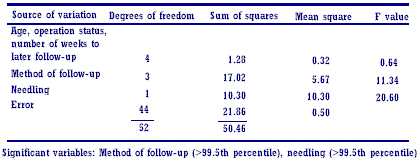
Table 7. Analysis of Covarience for "Weeks of Time Loss"

Patients who have chronic low-back pain usually have few detectable concurrent physical findings, and it is not unusual for progress to be monitored by the patient's subjective complaints; however, we have recently reported that many subtle signs related to neuropathy and denervation supersensitivity rather than gross denervation are usually present. These include trophedema, slight increase of muscle tone, and abnormal autonomic reflexes (sudomotor, vasomotor, and pilomotor). In this study, we have found that these subtle signs generally resolved after treatment and the abolition of symptoms, thus in many instances providing objective evidence of improvement.
The prolonged or permanent relief of some forms of pain by short-acting local anesthetic blocks at trigger zones, brief stimulation by intense cold, injection of normal saline solution, or dry needling have all been reported previously. The similarity between hyperstimulation analgesia and dry needling has not gone unnoticed, nor have the spatial coincidences among trigger points, acupuncture points, and muscle motor bands. Motor bands are not tender to pressure under normal circumstances, but hyperalgesia may develop following neuropathy of the innervating nerve and the subsequent development of denervation supersensitivity. Most patients who have persistent low-back pain appear to have those tender motor bands, and the technique for their desensitization by dry needling described in this paper is seen to offer effective deliverance. It is possible that relief is the result of stimulation-induced analgesia (stimulation of large-diameter fibers) or the displacement of nociceptors by fibrotic tissue. An interesting new concept is that the current of injury causes a decline in denervation hypersensitivity. It has been demonstrated that stimulation through implanted electrodes abolishes hypersensivity to acetylcholine, with the sensitivity of stimulated fibers eventually becoming as low as or lower than that of normally innervated fibers. Stimulation applied continuously is reported to be more effective than stimulation applied intermittently.
The procedure described in this paper (which requires demonstration) many be time-consuming. While not without danger in unskilled persons, it is a relatively safe technique (without the iatrogenic side effects of injected drugs) in the hands of a trained person who has a knowledge of anatomy. It has similarities with other trigger point desensitization procedures, but in this procedure the selection of points is on an anatomic basis. Its rewards in terms of pain mitigation and alleviation of symptoms should justify the procedure in the large proportion of chronic low-back pain patients in whom myofascial pain with neuropathy, rather than skeletal irritation, is the dominant disabling feature.
© iSTOP - Institute for the Study and Treatment of Pain - 2002